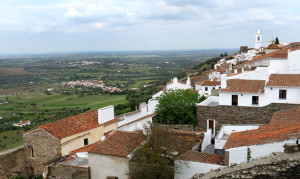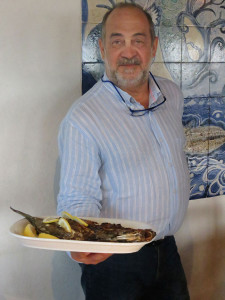To North Americans looking for sun, surf, landscapes, culture, history, and world-class cuisine in one destination, Portugal typically is not top of mind, but once they experience this easily accessible, hospitable land, they’ll likely want to return.
One of the safest travel destinations, where English is widely spoken, Portugal offers some of the best lodging and dining values in Europe. Of the 9.4 million international travelers who visited Portugal in 2014 (nearly equal to the country’s population of 10.4 million), less than four percent (360,000) came from the U.S. Portugal, however, is stepping up its efforts to attract more American tourists, relying mainly on a social media campaign.
Although many visitors to Portugal head to Porto, Lisbon, or the Algarve, the Alentejo region, a sun drenched land of lush vegetation, low hills, and sparkling seashores, comprising one-third of the mainland, offers a pleasing alternative to the hustle and bustle that often characterizes modern tourism.
Alentejo, which means “land beyond the Tagus,” is bordered by the Tagus River in the north, the Algarve in the south, Spain to the east, and the Atlantic on the west. It’s the least populated of the country’s seven regions (including the Azores and Madeira archipelagos), which likely accounts in part for its unrushed character.
Tourism is growing. In 2014 Alentejo welcomed 30% more foreign visitors over the year before. Ruben Obadia of the Alentejo Tourism Board attributes this growth to a two-pronged strategy launched two years ago: active promotion among the region’s population to showcase their offerings and aggressive outreach to influencers abroad.
Currently, the U.S. ranks with Spain, the U.K., France, Germany, and Brazil among the top six countries sending tourists to Alentejo. To accommodate all, the region offers 15,000 hotel beds – from B&Bs to four- and five-star, full-service establishments, along with many boutique hotels.
“We’re not looking to build high-end resorts. We want people to be in touch with the land,” Obadia said. “Our approach is to have Alentejo be true to itself, which is why we say when you’re here it’s time to be happy.”
To that end, Alentejo focuses on five types of tourism: culture (shaped by Roman, Moorish, and medieval influences), gastronomy (imaginative, always fresh, with master classes for gourmands), natural (embracing an extensive system of natural and national parks), active (including cycling, hiking, horseback riding), and sun and sea (featuring a natural, undeveloped shoreline and the best surfing in Europe).
Alentejo produces about two-thirds of the world’s cork and what is widely acknowledged to be some of the world’s best cured ham, olive oil, and wines. The very finest products receive protected origin designation, known as DOP (short for Denominação de Origem Protegida), and manufacture of DOP-designated products is tightly controlled to ensure authenticity. For example:
Dry-cured ham, known as presunto (similar to Italian prosciutto). Free-ranging black pigs, also known as Porco Preto or Iberian pigs, feed on acorns from cork oak trees to yield this moist, aromatic delicacy. Casa do Porco Preto in Barrancas now welcomes visitors, who don white coats, hair nets, and booties, to tour its ultra-modern processing facility.
Olive oil. The Alentejo Interior and North Alentejo are two of Portugal’s six DOP, olive oil producing regions. Rules stipulate the variety of olives to be used and how and when they’re harvested and processed. The very best oil—Extra Virgin Selecção—comes from Alentejo and is used in salads, grilled vegetables, and in pastries and other delicacies.
Wines. Alentejo wines have made a big comeback in the last 10 years, thanks largely to the creation of Lake Alqueva, one of Europe’s largest manmade lakes, which has encouraged 200 wine producers to cultivate grapes. The Cartuxa reds and whites regularly bring home awards in international competitions. Portugal boasts 250 varieties of grapes, all of which are used in wine production, compared to Italy which taps only 10% of its grape varieties for wine.
Since the region and the country as a whole can’t compete with larger nations in terms of quantity, it focuses on quality. Much of Alentejo’s cured ham and olive oil, for example, is exported to Spain, Italy, and elsewhere, selling at significantly higher prices.
Getting to know Alentejo means meeting people and exploring local sites.
Carlos Barros, a proud Alentejão, greets you with a warm smile at his fish restuarant, Arte & Sal in São Torpes on the Praia de Morgavel, about six miles south of Sines. And he’ll ply you with regional specialites.That may mean starting with a platter of mussels steamed in an olive oil-garlic broth, followed by grilled John Dory fish served with migas, a side dish of breadcrumbs and garlic sauté that is found in every home, accompanied by a moderately chilled Caios, white wine from Terras do Sado. You’ll finish off with a dessert of encharcada, only found in Alentejo. Similar to crème brûlée, its made from sugar, eggs and egg yolks, lemon and cinammon, and slighlty scorched with a blowtorch.
A visit to Alentejo is not complete without stopping in the walled city of Évora, about 65 miles east of Lisbon. The capital city of Alentejo, and its largest with 56,000 people, Évora is a UNESCO World Heritage Site that traces its origins back 6,000 years. One can still see megaliths from that time. Évora got its name from the Romans, who ruled until the Visigoths took over in the fifth century. Next came the Moors, and in 1166 the Portuguese first ruled the city. Eminently walkable, one can take in the remains of a Roman temple near the city center, close by the Cathedral.
Head east from Évora to the enchanting hilltop village of Monsaraz located on the Guadiana River. With a population of a few hundred, this walled locale is one of the oldest inhabited sites in southern Portugal. The Torre das Feiticeiras (Witches’ Tower) offers commanding views of the region, including Spain, only a stone’s throw away.
While in Monsaraz, make your way to the Horta da Moura Hotel where a 2,450-year-old olive tree still produces fruit. Three trunks, each about three feet in diameter, branch out from the ground. For a special treat, sample its olives and oil, under its shade, accompanied by a white Vinha d’Ervideira from Alentejo. That will only whet your appetite, which will be more than satisfied in the hotel’s restaurant. Try the region’s specialty starter of scrambled eggs with asparagus and coriander. Complement it with a main course of bacalhau—cod, Portugal’s most popular dish—flavored with garlic, vinegar, and salt.
Finding a comfortable room for the night in Alentejo is easy. Consider a Pousada, a historical building that has been converted into a luxury hotel; there are 44 in Portugal.
The Pousada de Beja, a former, thirteenth century convent located in Beja, a town about 60 miles east of Sines, offers 35 rooms. High ceilings and white walls in the public areas create an atmosphere of calm and elegance. The restaurant, formerly a refectory, serves a number of regional specialties, including rabbit, lamb, octopus, and, yes, bacalhau. Sample the farinheira, a smoked sausage made from flour, invented by sixteenth century Jews looking to fool the Inquisition into thinking they were Catholics who ate pork sausages, and which is now popular throughout Portugal.
For an unusual treat, check in at the Alentejo Marmòris Hotel & Spa in Vila Viçosa, the marble capital of Portugal. Built by the Alves family, which has been operating quarries for 25 years, this 45-room hotel celebrates the stone. Every hallway and public space displays a wide variety of marble that bedazzle. The rooms are tastefully modern, each one incorporating slightly different design elements. The restaurant, Narcissus Fernandesii, is splendid. If you have a sizable group, you’ll sit around a 10-by-16-foot marble block, surmounted by a one-inch-thick, single-piece glass top. The local cuisine is equally stunning – sausage with black truffle, delicately textured and flavored tongue in wine sauce, among other regional specialties.
Visit Alantejo, www.visitalentejo.pt


